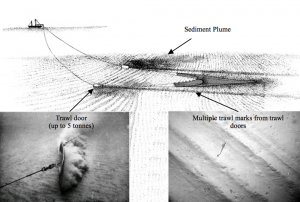10 December 2013
Trawling is a drag for continental shelf’s sediments

Caption: Trawling leaves marks and displaces ocean sediments
Credit: Upper: De Alteris, 1999; lower: Main and Sangster, 1981; Ocean Survey 20/20, 2007.
While Global Positioning Systems are normally deployed to locate lost cell phones or navigate tricky driving routes, satellite tracking could help ocean researchers better understand how fishermen’s nets scrape away sediment on the continental shelf.
When rivers flow into the ocean, bits of rock and mud deposit onto the granite base of the underwater perimeters of continents, creating layers of sediment. Thicker layers more adequately nourish benthic organisms – bottom-dwelling scavengers like nematodes and crustaceans that feed fish eaten by humans.
“The food chain depends on these sediments,” said Ferdinand Oberle, an ocean sciences doctoral student at the University of Bremen, during a poster session Monday at the American Geophysical Union’s Fall Meeting. When sediments thin, the bottom of the food web crumbles, he said
Oberle and his team created the first map that charts the thickness of sediments along Galicia, a region near northwestern Spain. The map will be published in the Journal of Continental Shelf Research in 2014.
They were surprised to find that the average thickness of sediment on the shelf was only 1.5 meters – a significant drop from the expected average of 10 meters, said Oberle. In addition, only about 35 percent of sediment from rivers stays on the shelf between depths of 40 to 140 meters. The remaining 65 percent is deposited deep into the ocean.
These results were surprising, said Oberle, as large parts of the shelf not only experienced sediment thinning, but some areas completely lacked layers. “We expect sediment to be 20 meters thick in large parts, but the maximum we have is 7 meters,” Oberle said.
The team suspected a possible source of the diminishing layers: a method of fishing, called trawling, that pulls a five ton net across the bottom of the ocean floor. But proving that fishing boats were disrupting the seafloor ecosystem was challenging – as evidenced by the past 10 years of other teams’ failed attempts at showing the correlation.
Oberle and his team, which included Chris Reddy, a leading oil expert in the U.S. and Peter Swarzensky a U.S. Geological Survey expert on lead dating, managed to obtain a year’s worth of GPS tracking data from fishing boats in the region between 2011 and 2012. By analyzing the way boats turned and how fast they went, the team could determine whether they were trawling.
They developed a three-pronged approach quantifying the extent of trawling and calculating how much it disrupts sediments along the shelf by using simple X-rays, lead dating and 3D chromatography.
Through this analysis, Oberle and his team not only compiled the first map charting rampant trawling along Galicia, but they also showed – via the three independent methods – that trawling was most likely mixing and re-suspending sediment in the area, displacing 1 megaton to 1.6 megatons of sediment during the year. Given that earlier research showed that rivers deposit 2.25 megatons of sediment annually, this data suggested that a solid half of the shelf’s sediment is re-suspended by trawling.
“They’re essentially plowing every inch of the shelf,” said Oberle.
While the results don’t address human impacts on erosion, Oberle hopes to apply the data toward that area of research in the future. He also aims to publish the three methods and refine his sediment re-suspension calculations to be more precise.
According to Oberle, this is only the beginning of a fascinating story of the trawls effects on sediment health.
– Julia Calderone is a science communication graduate student at UC Santa Cruz.



 GeoSpace is a blog on Earth and space science, managed by AGU’s Public Information staff. The blog features posts by AGU writers and guest contributors on all sorts of relevant science topics, but with a focus on new research and geo and space sciences-related stories that are currently in the news.
GeoSpace is a blog on Earth and space science, managed by AGU’s Public Information staff. The blog features posts by AGU writers and guest contributors on all sorts of relevant science topics, but with a focus on new research and geo and space sciences-related stories that are currently in the news.